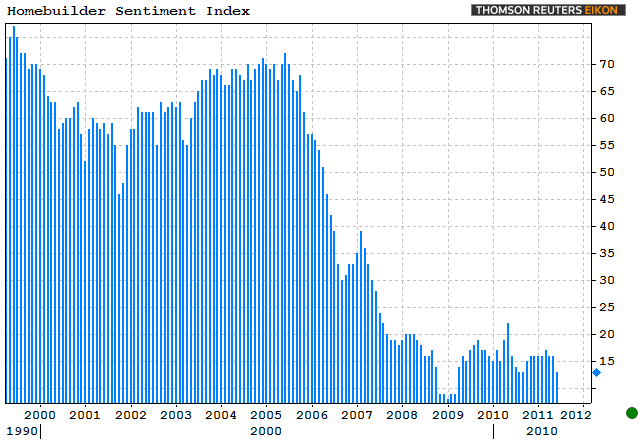The National Association of Homebuilders (NAHB) today reported that its Housing Market Index (HMI) fell to 13 after standing at 16 for six out of the last 7 months seven months. The HMI is a measure of builder confidence gleaned from homebuilders' responses to a monthly survey that has been conducted by NAHB for over 20 years.
"Builders are being squeezed by the continuing weakness in existing-home prices - against which they must compete -- as well as rising material costs," said NAHB Chairman Bob Nielsen, a home builder from Reno, Nevada. "In addition to the ongoing impacts of distressed property sales on home prices, appraisal values and consumer confidence, rising costs for materials such as roofing, copper, wallboard, vinyl siding and other components have made it extremely difficult to construct a new home and sell it at a price that covers the costs."

The NAHB/Wells Fargo survey asks homebuilders to gauge both current single-family home sales and their expectations for those sales over the next six months as "good," "fair," or "poor." They are also asked to rate current traffic of perspective buyers as "high to very high," "average" or "low to very low." In addition to the composit HMI, a component index is constructed for each of the three sets of responses. A score over 50 on any index indicates that more builders view sales conditions as good rather than as poor. The index has not had a score over 50 since late in 2006.
Every component of the HMI fell in June. The component measuring buyer traffic decreased 2 points to 12 after last month's reading of 14 was the highest since May 2010. Current Sales Conditions also fell 2 points, bringing that component of the index to 13. Sales Expectations fell from 19 to 15, matching record lows from February and March of 2009.
"Builder confidence has waned even further as economic growth has stalled, foreclosures have continued to hit the market and the cost of building a home has risen," agreed NAHB Chief Economist David Crowe. "Meanwhile, potential new-home buyers are being constrained by difficulty selling their existing homes, stringent lending requirements, and general uncertainty about the economy. Economic growth must pick up in order for housing to gain the momentum it needs to get back on track."
Regionally, the HMI results were mixed, with the Northeast actually rising 2 points while the West represented the other end of the spectrum, falling 4 points. The midwest and south dropped 3 and 2 points respectively.







